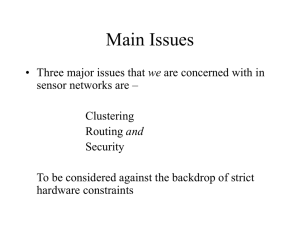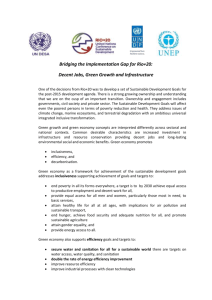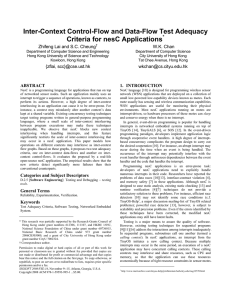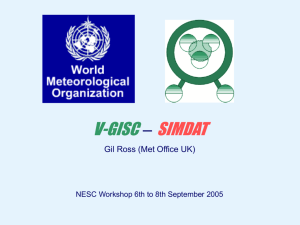Kirby, Peadar
advertisement
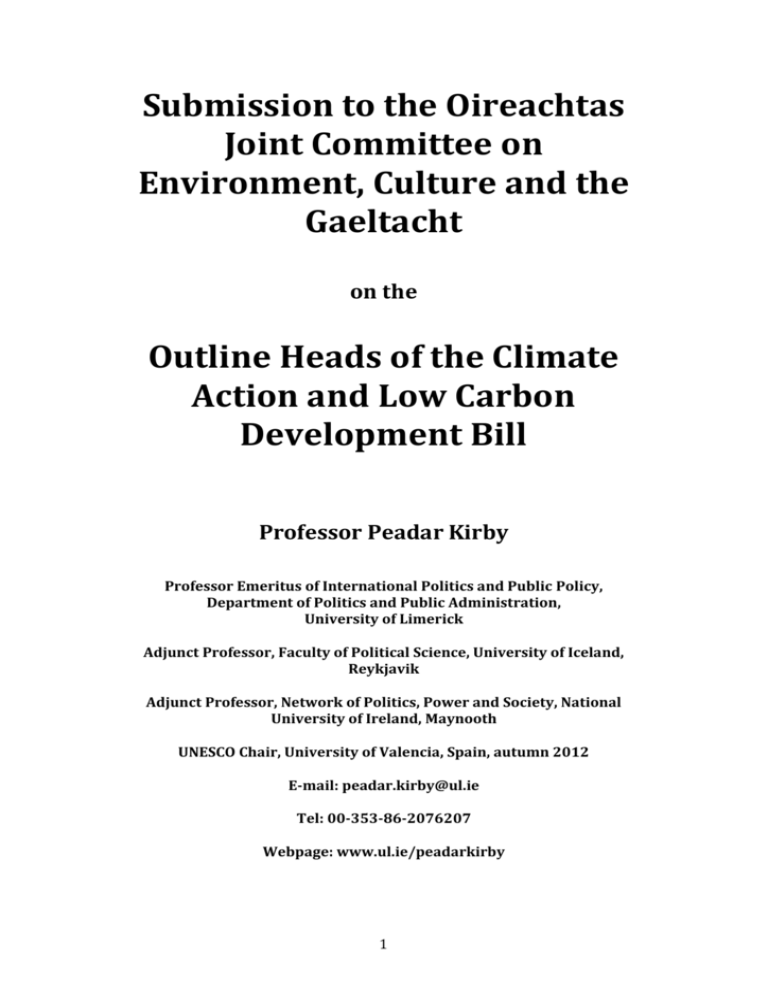
Submission to the Oireachtas Joint Committee on Environment, Culture and the Gaeltacht on the Outline Heads of the Climate Action and Low Carbon Development Bill Professor Peadar Kirby Professor Emeritus of International Politics and Public Policy, Department of Politics and Public Administration, University of Limerick Adjunct Professor, Faculty of Political Science, University of Iceland, Reykjavik Adjunct Professor, Network of Politics, Power and Society, National University of Ireland, Maynooth UNESCO Chair, University of Valencia, Spain, autumn 2012 E-mail: peadar.kirby@ul.ie Tel: 00-353-86-2076207 Webpage: www.ul.ie/peadarkirby 1 1) Introduction: The purpose of the Outline Heads of the Climate Action and Low Carbon Development Bill is to enable the Government to undertake the necessary actions to achieve the successful transition to a low carbon, climate resilient and environmentally sustainable economy between now and 2050. The recognition of this objective in law is greatly to be welcomed. However, the substance of the Bill relates to what can be called the infrastructure which might help deliver this objective. The substantial measures to be taken to actually get us there will only be known once the national low carbon roadmap is published and so cannot yet be commented upon. This submission therefore restricts itself to comments on the adequacy of the infrastructure proposed and on the list of accompanying conditions in Section 10 of Head 5. 2) Executive summary: This submission is divided into five sections. The first deals with the absence of targets, the second with the allocation of responsibility for the delivery of the Bill’s objectives, the third with the list of conditions which the measures to achieve the Bill’s goal have to take account of, the fourth with the composition and role of the National Expert Advisory Body, and the final section with the significance of the limitation of the objective to a low-carbon economy and the absence of any objective of a low-carbon society. A brief list of references is included at the end. 3) List of recommendations: Robust and regular targets must be included in the Bill Overall responsibility should be allocated to the Taoiseach and his/her Department No conditions should be included that appear to make the achievement of the objectives of the Bill subservient to economic growth and development Detailed consideration needs to be given to a more adequate advisory body or bodies, at arm’s length from government, and including leading experts in relevant fields The objective of a low-carbon and resilient society needs to be given equal weight with that of a low-carbon economy. 4) Main body: 2 a) Absence of targets: The absence of explicit mention of national targets in the Bill and its limitation to fulfilling EU and UNFCCC targets is notable. It signals a lack of national conviction of the vital importance of meeting GHG reduction targets and a passive following of the lead of others. This is far from the call in the recent NESC climate change report that Ireland should offer international leadership on the practical means to achieve decarbonisation. Not only should Ireland be seen to be establishing its own targets equal to those we are obliged to meet under international agreements but we should be showing an ambition to go beyond international targets thus offering the leadership called for by NESC. The fact that the NESC report itself took the emphasis off targets was most unfortunate, setting up an entirely spurious opposition between top down targets and bottom up measures to achieve them. The words of John Ashton, the Special Representative for Climate Change in the UK Foreign Office from 2006-12 and a Fellow of the European Climate Foundation, in a recent speech are apposite. Speaking to the UK Met Office in April 2013, he said: ‘The choice between bottom up and top down is a false choice. Bottom up activity is taking place all the time and will continue. The real choice is between bundling together what we would do anyway and pretending it will solve the problem, or imposing in addition an action-forcing mechanism, in the form of legally binding targets as in our Climate Change Act, to ensure that the pace on the ground matches the ambition we need. We need top down as well as bottom up, not instead of it.’ And in a comment on those advocating a focus on the bottom up rather than the top down which seems directly applicable to the NESC report, he added: ‘The voice is a siren voice, drawing us towards rocks. If we heed it we will be choosing what we think we can easily do not what we must do. We will be giving up’ (Ashton, 2013: 6). It is very important that these words be heeded and that the draft Bill be strengthened with the inclusion of robust targets that reflect the national will to succeed in this audacious but vital endeavour. b) Allocation of responsibility: Allocating the principal responsibility for the achievement of the objectives set out in the draft Bill to the Minister for the Environment again sends signals of a lack of understanding at government level of the extreme national effort that will be required to achieve the radical 3 objectives set out in the text. As experts in climate change keep emphasising, what we are facing is a global emergency of possibly catastrophic proportions which the international community has continuously underestimated. As the World Bank emphasised in its recent and alarming report Turn Down the Heat, our present trajectory is putting us on target for close to a 4°C of warming by 2060 (World Bank, 2012). The world’s states are therefore being called to a major national effort to take the radical measures necessary to being immediately reducing their GHG emissions annually. The scale of the actions required need leadership from the top, both to signal to the whole state sector and to society the absolute seriousness of what is being undertaken, and also to help ensure that obstacles imposed within the state bureaucracy and by vested interests outside are overcome to help achieve success. Therefore operational responsibility for actions on climate change should be vested in a special unit with the Dept. of the Taoiseach with appropriate horizontal links to key departments such as energy, environment, transport, agriculture, foreign affairs and finance. c) List of conditions: Some of the conditions in Section 10 of Head 5 suggest that the goal of a low-carbon economy is subservient to such goals as ‘sustainable development’, ‘economic impact’, securing and safeguarding economic development and competitiveness, taking advantage of economic opportunities, 4 least cost, and maximising economic efficiency. The writing of these conditions into law is very problematic as the state of our scientific and economic knowledge at this point in time poses real tensions between the goal of GHG reductions and the wider growth economy that our national development is premised upon. Two examples will suffice to illustrate this point. Research shows that GDP growth of even 1-2 per cent negates gains from energy efficiencies as it increases consumption thereby severely undermining the role that efficiencies can play in achieving robust targets of decarbonisation (Herring and Roy, 2007: 202). Anderson, a leading scientific expert, goes as far as to say that ‘climate change commitments are incompatible with short- to medium-term economic growth’, something he says ‘few if any scientists working on climate change would disagree with’ (Anderson and Bows, 2012: 640). These examples show that science is drawing our attention to the fact that there exist real tensions, and perhaps even contradictions, between the goals of decarbonisation and economic development as current envisaged. From the social sciences comes another example which alerts us to the challenges decarbonisation poses to social policy. Ian Gough, a leading social policy expert at the London School of Economics concluded in a recent article: ‘It is safe to conclude that moving to low carbon lifestyles will require forms of collective action that go well beyond current government strategies for climate change mitigation’. He too was drawing attention to the challenge to our dominant developmental paradigm posed by the need drastically to reduce GHG emissions (Gough, 2013: 206). There is also an extensive literature in sociology and economics that argues about the need to move to a ‘steady-state economics’ (Herman Daly’s term) or ‘prosperity without growth’ (Tim Jackson). On the continent, there is now an extensive literature on degrowth, posing real challenges to the dominant ways we have organised our economic and social development for more than a century (Fournier, 2008; Garcia, 2012). In the light of these emerging strands of thinking, it seems most unwise to write into law conditions that effectively tie the objective of decarbonisation to our current growth-based economy. The basic question to be asked is: if we find that we have to make a choice between some elements of economic growth and competitiveness and the achievement of the very difficult goals that this draft Bill proposes, which objective will take precedence? To achieve the goals of this Bill, we face a very steep learning cure in economics, sociology, political science, and development studies. It would be rash to effectively foreclose what new ways we may learn about organising our economic, social and political lives and that will be necessary if we are to achieve the decarbonisation of the economy and society. d) Composition and role of the National Expert Advisory Body: The body outlined in the draft bill is a very pale shadow indeed of what was recommended in the NESC report and offers nothing of the potential of that recommendation. Indeed, what is outlined here seems to run directly counter to the need as 5 identified by NESC. The one concrete institutional recommendation in the NESC report centres on the need to avoid going the route that Britain chose, namely establishing a climate change commission which is an independent, high-level advisory body to government. The NESC report doubts that this is the best route for Ireland as it ‘can mitigate against achieving real commitment, technical engagement and action within government and its agencies’ (NESC, 2012: 41; emphasis in the original). Instead the NESC recommends ‘a new process and entity to help drive Ireland’s transition to carbon neutrality’ (44), carefully designed and part of a wider reform process in other spheres. This would have a national steering and oversight board possibly chaired by a Cabinet Minister, a technical reporting and monitoring group collating and analysing the reports from the agencies and networks, and a range of problem-solving networks with the many public and private bodies already undertaking initiatives towards decarbonisation. The ‘strategic building blocks of Ireland’s transition to a carbon-neutral economy and society’ (52) (renewable energy, energy efficiency, sustainable transport, carbon-neutral agriculture and resource management), then form the core of ‘a conscious and disciplined exploration and testing of policy possibilities and a process capable of identifying and scaling those actions which prove most promising’ (66). None of this dynamic is captured by what is outlined in the Outline Heads of Bill. The important principles that need to inform whatever expert advisory body to be established are: i) that it has a majority of members who are not state employees and who therefore feel free to offer critical and contrary advice; ii) that they are nominated by a body other than the Minister; and iii) that they have sufficient powers to influence the direction of policy. Careful consideration needs to be given by the Joint Committee to how these goals might be achieved. One idea would be to add an expert scientific group, made up of leading experts from a range of disciplines (the social sciences as well as hard sciences and technologies), which would have the right to nominate half the expert group. The distinction between the two groups would be that the former would provide independent scientific advice while the latter would have a direct input into the formulation and regular evaluation of policy. The appointment of the expert group of scientists might, for example, be given to the heads of the seven universities to ensure that the best expertise is made available. e) Towards a low-carbon society: It may seem of minimal importance to draw attention to the limitation of the objectives contained in the draft bill to the achievement of a low-carbon economy. However, the actions required to achieve decarbonisation are by no means limited to the economy and will require major changes of lifestyle and consumption by all citizens, especially the most affluent 6 and most mobile. The exclusive focus on the economy in the draft bill therefore has the effect of limiting the range of actions required to those relating to the economy alone, thereby avoiding the challenge of massive change in social mores and expectations that are just as important. Indeed, the latest evidence shows that, in the developed world, consumption now constitutes a greater cause of GHG emissions than does production (it is the opposite in the developing world). Therefore, the objective of a low-carbon society must be included as being of equal importance to that of a low-carbon economy if the Bill is to address the range of challenges involved. References: Anderson, Kevin and Alice Bows (2012): ‘A new paradigm for climate change’, in Nature Climate Change, Vol 2, September 2012, pp 639-40. Ashton, John (2013): ‘Climate Change and Politics: Surviving the Collision’, speech to the Met Office, Exeter, 11th April 2013. Daly, Herman E. (1991): Steady-State Economics, Washington DC: Island Press. Fournier, Valérie (2008): ‘Escaping from the economy: the politics of degrowth’, in the International Journal of Sociology and Social Policy, Vol 28, Nos 11/12, pp 528-45. Garcia, Ernest (2012): ‘Degrowth, the past, the future, and the human nature’, in Futures, Vol 44, pp. 546-52. Gough, Ian (2013): ‘Carbon Mitigation Policies, Distributional Dilemmas and Social Policies,’ in Journal of Social Policy, 42, pp 191-213. Herring, Horace and Robin Roy (2007): ‘Technological innovation, energy efficient design and the rebound effect’, in Technovation, 27, pp 194-203. Jackson, Tim (2009): Prosperity without Growth: Economics for a Finite Planet, London: Earthscan. NESC (2012): Ireland and the Climate Change Challenge: Connecting ‘How Much’ with ‘How To’, Dublin: NESC. World Bank (2012): Turn Down the Heat: Why a 4°C World Must be Avoided, Washington DC: The World Bank 7
